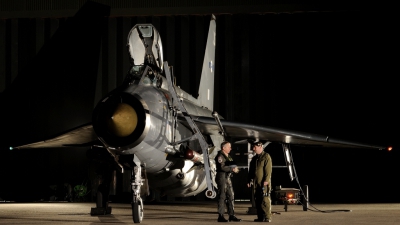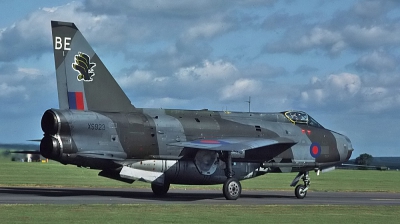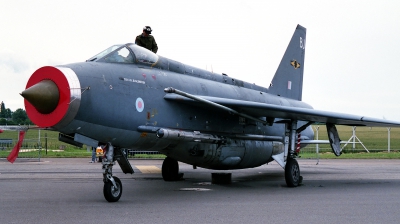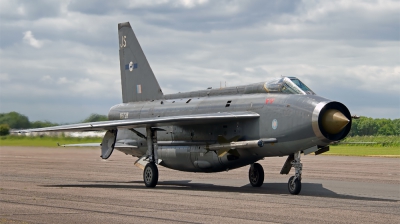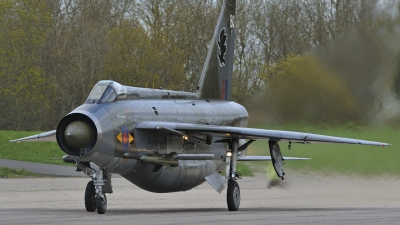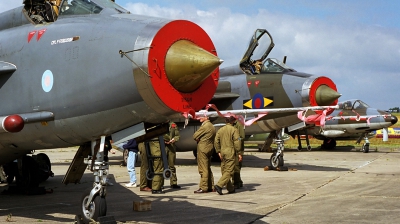English Electric Lightning F6 Aircraft Data
The Lightning F.6 was the ultimate Lightning version of the RAF, with the first aircraft entering service with the newly formed No.5 Squadron at RAF Binbrook in December 1965. These aircraft were actually former F.3 aircraft brought up to F.6 (Interim) standard, also referred to as the Lightning F.3A and earlier as the 'Extended Range F.3'. The operational range of the early Lightning marks (F.1, F.1A and F.2) had been acknowledged as a critical factor even though the aircraft was initially developed for a specific home defence role. The primary role for the Lightning in the 1960s was that of an interceptor, protecting Britain's V-Bomber bases against Sovjet air attack. It was also thought that the cannon armament of these versions could be dispensed with, relying only on the use of air-to-air missiles. Therefore the cannon armament in the F.3 version was deleted. However, soon after the development of this new mark, a further change in defence policy saw the Lightning not only as an interceptor but also as an air superiority fighter. This required the aircraft to be armed with cannon and the also an increase in combat range. These requirments were incorporated in the F.3A (F.6 Interim) and eventually in the final production aircraft, the Lightning F.6.
More teeth and more range
Whereas the two 30mm Aden cannon were mounted in the upper part of the forward fuselage with their muzzles in front of the cockpit windscreen, the twin gunpack of the F.6 was placed as an interchangeable self-contained unit in the forward section of a newly designed feature to the underside of the aircraft's fuselage: an are-ruled ventral pack. The forward section could so either hold a weapons bay with two 30mm Aden cannon or hold an extra fuel cell. Without cannon, the all-fuel pack had a capacity for 610 Imperial gallons (2,773 litres); with the two Aden cannon the fuel capacity was reduced to 535 Imperial gallons (2,434 litres). The landing flaps had also been reconstructed to take another 33 Imperial gallons (150 litres) of fuel each.
As early as 1963 BAC had been authorised to develop a long(er)-range version of the Lightning, mainly so that it could be ferried out to distant corners of the Empire such as Singapore in relatively short time. A redesigned wing, the CLE-wing (Cambered Leading Edge) with a kinked cambered leading edge was introduced into the P.1B in 1956/7 to improve the cruising range. These wings became the norm on the F.3A, the F.6 and the F.2A. Another step taken was the strengthening of the wing to allow two 260-Imperial gallon (1,200 litres) overwing fuel tanks to be carried. These were jettisonable in an emergency but gave the F.6 a substantially improved deployment capability. The non-stop range of the F.6 increased by approximately 250 nm to 1,350 nm. The overwing fuel tanks were first tested in 1961 on F.2 XN725. Initially the tanks featured tail fins, but these were later dispensed with. The F.3A and the later F.2A had no provision for overwing tanks.
Enter the F.6
Before converting to their new mount, No. 5 Squadron at RAF Binbrook, had been stationed in Germany flying Gloster Javelins out of RAF Geilenkirchen. Their first aircraft (F.6 Interim) XR755 and XR756 arrived at the Lincolnshire base on 10 December 1965. It took to March 1966 before the squadron had received all of its aircraft. The first full production F.6 (XR768) to come off the production line was delivered to the second RAF F.6 unit, No.74 Squadron, at RAF Leuchars, on 1 August 1966. By December they had their full complement of 12 Lightnings delivered. Here at Leuchars the unit trialled the fitting of a spring-loaded arrestor hook, resulting in the retrofit on all F.6 aircraft. This feature was also incorporated in the later F.2A.
Prior to their deployment to RAF Tengah, Singapore, the Tigers were engaged in a series of in-flight refuelling tests to evaluate the combination of air-to-air tanking and the use of overwing tanks as well as to see how aircraft and aircrew survived on these prolonged (five hour) flights. On 4 June 1967, Exercise 'Hydraulic' started with the first six Lightnings taking off from Leuchars heading for Singapore. With staging posts in Cyprus, the Persian Gulf, and Gan in the Indian Ocean, the Lightnings reached Tengah without incident. By 11 June all squadron aircraft had arrived. No.74 Squadron spent four years in the Far East. On return to home shore in 1971, the unit left their Lightnings at RAF Akrotiri to be taken over by No.56 Squadron.
In Scotland, No.11 Squadron had received her first Lightnings in April 1976. This unit joined No.5 Squadron at Binbrook in March 1972. The other Leuchars based unit, No.23 Squadron took delivery of their first F.6s in May 1967. No.111 Squadron at RAF Wattisham had been operating the F.3 when the got their first (and only) three F.6s in May 1974. Their joy was shortlived however, as the unit disbanded in September of that year in preparation of the introduction of their new mount, the Phantom.
Apart from the operational squadrons, the Lighting F.6 was used in small numbers by the Air Fighting Development Squadron (AFDS), the Fighter Command Trials Unit (FCTU) and the Lightning Training Flight (LTF) at RAF Binbrook.
Production, construction numbers and serials
In 1962 XP693 (c/n 95116) was withdrawn from the F.3 production line and converted to F.3A (F.6 Interim) standard. A further two aircraft were to join the Extended Range programme: XP698 (c/n 95152) had been selected to become the trials aircraft for the ER programme, but was damaged in a ground run and had to be replaced. Lightning F.3 XP697 (c/n 95151) first flew on 18 July 1963 and was flown later that day to Filton for conversion and so became the new trials aircraft. Her first flight as an F.3A/F.6 Interim was made on 17 April 1964. The first production F.6 Interim, XR752, first took to the air on 16 June 1965. The first full-production F.6, XR768, made her first flight on 24 November 1965.
A total of 62 Lightning F.6 (including conversions) were produced:
Seven F.3 aircraft were converted at Warton to F.6 standard: XR723 to XR728 (c/n 95206 to 95211) and XR747 (c/n 95212).
Sixteen aircraft were built at Samlesbury to F.6 (Interim F.6) but later converted at Warton to full F.6 standard: XR752 to XR767 (c/n 95217 to 95232).
The remaining 39 aircraft were built at Samlesbury to full F.6 standard. These were divided in three serial blocks: XR768 to XR773 (c/n 95233 to 95238); XS893 to XS904 (c/n 95239 to 95 250); XS918 to XS938 (C/n 95251 to 95271).
Of note is, that an additional four F.3 aircraft (XR748 to XR751) were held at Warton pending conversion to F.6. Eventually they were delivered to the RAF as F.3, except XR749, which was partially modified to F.6, but later 'de-modded' back to F.3 standard.
More teeth and more range
Whereas the two 30mm Aden cannon were mounted in the upper part of the forward fuselage with their muzzles in front of the cockpit windscreen, the twin gunpack of the F.6 was placed as an interchangeable self-contained unit in the forward section of a newly designed feature to the underside of the aircraft's fuselage: an are-ruled ventral pack. The forward section could so either hold a weapons bay with two 30mm Aden cannon or hold an extra fuel cell. Without cannon, the all-fuel pack had a capacity for 610 Imperial gallons (2,773 litres); with the two Aden cannon the fuel capacity was reduced to 535 Imperial gallons (2,434 litres). The landing flaps had also been reconstructed to take another 33 Imperial gallons (150 litres) of fuel each.
As early as 1963 BAC had been authorised to develop a long(er)-range version of the Lightning, mainly so that it could be ferried out to distant corners of the Empire such as Singapore in relatively short time. A redesigned wing, the CLE-wing (Cambered Leading Edge) with a kinked cambered leading edge was introduced into the P.1B in 1956/7 to improve the cruising range. These wings became the norm on the F.3A, the F.6 and the F.2A. Another step taken was the strengthening of the wing to allow two 260-Imperial gallon (1,200 litres) overwing fuel tanks to be carried. These were jettisonable in an emergency but gave the F.6 a substantially improved deployment capability. The non-stop range of the F.6 increased by approximately 250 nm to 1,350 nm. The overwing fuel tanks were first tested in 1961 on F.2 XN725. Initially the tanks featured tail fins, but these were later dispensed with. The F.3A and the later F.2A had no provision for overwing tanks.
Enter the F.6
Before converting to their new mount, No. 5 Squadron at RAF Binbrook, had been stationed in Germany flying Gloster Javelins out of RAF Geilenkirchen. Their first aircraft (F.6 Interim) XR755 and XR756 arrived at the Lincolnshire base on 10 December 1965. It took to March 1966 before the squadron had received all of its aircraft. The first full production F.6 (XR768) to come off the production line was delivered to the second RAF F.6 unit, No.74 Squadron, at RAF Leuchars, on 1 August 1966. By December they had their full complement of 12 Lightnings delivered. Here at Leuchars the unit trialled the fitting of a spring-loaded arrestor hook, resulting in the retrofit on all F.6 aircraft. This feature was also incorporated in the later F.2A.
Prior to their deployment to RAF Tengah, Singapore, the Tigers were engaged in a series of in-flight refuelling tests to evaluate the combination of air-to-air tanking and the use of overwing tanks as well as to see how aircraft and aircrew survived on these prolonged (five hour) flights. On 4 June 1967, Exercise 'Hydraulic' started with the first six Lightnings taking off from Leuchars heading for Singapore. With staging posts in Cyprus, the Persian Gulf, and Gan in the Indian Ocean, the Lightnings reached Tengah without incident. By 11 June all squadron aircraft had arrived. No.74 Squadron spent four years in the Far East. On return to home shore in 1971, the unit left their Lightnings at RAF Akrotiri to be taken over by No.56 Squadron.
In Scotland, No.11 Squadron had received her first Lightnings in April 1976. This unit joined No.5 Squadron at Binbrook in March 1972. The other Leuchars based unit, No.23 Squadron took delivery of their first F.6s in May 1967. No.111 Squadron at RAF Wattisham had been operating the F.3 when the got their first (and only) three F.6s in May 1974. Their joy was shortlived however, as the unit disbanded in September of that year in preparation of the introduction of their new mount, the Phantom.
Apart from the operational squadrons, the Lighting F.6 was used in small numbers by the Air Fighting Development Squadron (AFDS), the Fighter Command Trials Unit (FCTU) and the Lightning Training Flight (LTF) at RAF Binbrook.
Production, construction numbers and serials
In 1962 XP693 (c/n 95116) was withdrawn from the F.3 production line and converted to F.3A (F.6 Interim) standard. A further two aircraft were to join the Extended Range programme: XP698 (c/n 95152) had been selected to become the trials aircraft for the ER programme, but was damaged in a ground run and had to be replaced. Lightning F.3 XP697 (c/n 95151) first flew on 18 July 1963 and was flown later that day to Filton for conversion and so became the new trials aircraft. Her first flight as an F.3A/F.6 Interim was made on 17 April 1964. The first production F.6 Interim, XR752, first took to the air on 16 June 1965. The first full-production F.6, XR768, made her first flight on 24 November 1965.
A total of 62 Lightning F.6 (including conversions) were produced:
Seven F.3 aircraft were converted at Warton to F.6 standard: XR723 to XR728 (c/n 95206 to 95211) and XR747 (c/n 95212).
Sixteen aircraft were built at Samlesbury to F.6 (Interim F.6) but later converted at Warton to full F.6 standard: XR752 to XR767 (c/n 95217 to 95232).
The remaining 39 aircraft were built at Samlesbury to full F.6 standard. These were divided in three serial blocks: XR768 to XR773 (c/n 95233 to 95238); XS893 to XS904 (c/n 95239 to 95 250); XS918 to XS938 (C/n 95251 to 95271).
Of note is, that an additional four F.3 aircraft (XR748 to XR751) were held at Warton pending conversion to F.6. Eventually they were delivered to the RAF as F.3, except XR749, which was partially modified to F.6, but later 'de-modded' back to F.3 standard.
- Country of Origin: United Kingdom
- First Flight: 17 April 1964
- Initial Service Date: 10 December 1965
- No. Built: 62
- No. In Service: 0
- No. of Hardpoints: 4
- Crew: 1
Power:
2 Rolls Royce RA.24R Avon Mk.301R at 12,690 lbf
Weapons:
Two Hawker Siddeley Dynamics Red Top infra-red homing air-to-air missiles.
Two 30mm Aden cannon.
Two 30mm Aden cannon.
Dimensions:
| Length: | 55 ft 3 in. |
| Wing Span: | 34 ft 10 in. |
| Wing Area: | 474,5 sq.ft |
| Height: | 19 ft 7 in. |
| Empty Weight: | 28,041 lbs |
| Max. Weight: | 41,700 lbs |
Performance:
| Service Ceiling: | 65,000+ ft. |
Operators:
United KingdomRoyal Air Force Lightning F.6 units were:
No.5 Squadron
No.11 Squadron
No.23 Squadron
No.56 Squadron
No.74 Squadron
No.111 Squadron (This unit had three F.6s on strength for a very short time only).
The following units, all three based at RAF Binbrook had the F.6 on strength:
Air Fighting Development Squadron (AFDS)
Fighter Command Trials Unit (FCTU)
Lightning Training Flight (LTF)
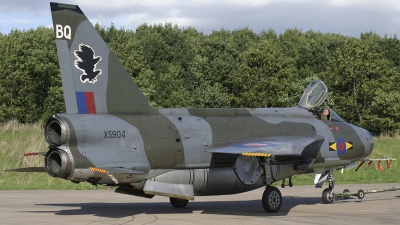
 Random great photos of the English Electric Lightning F6:
Random great photos of the English Electric Lightning F6:
